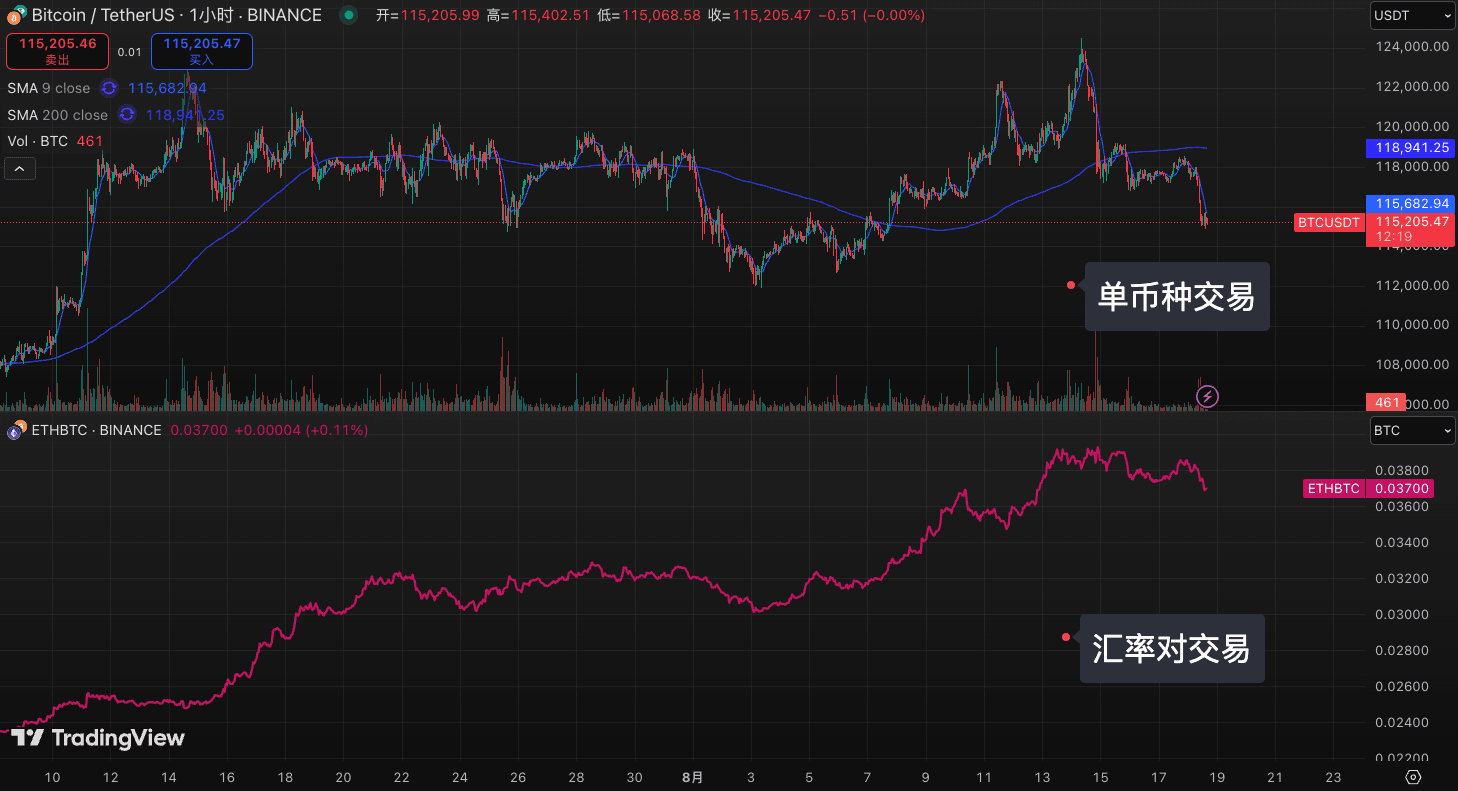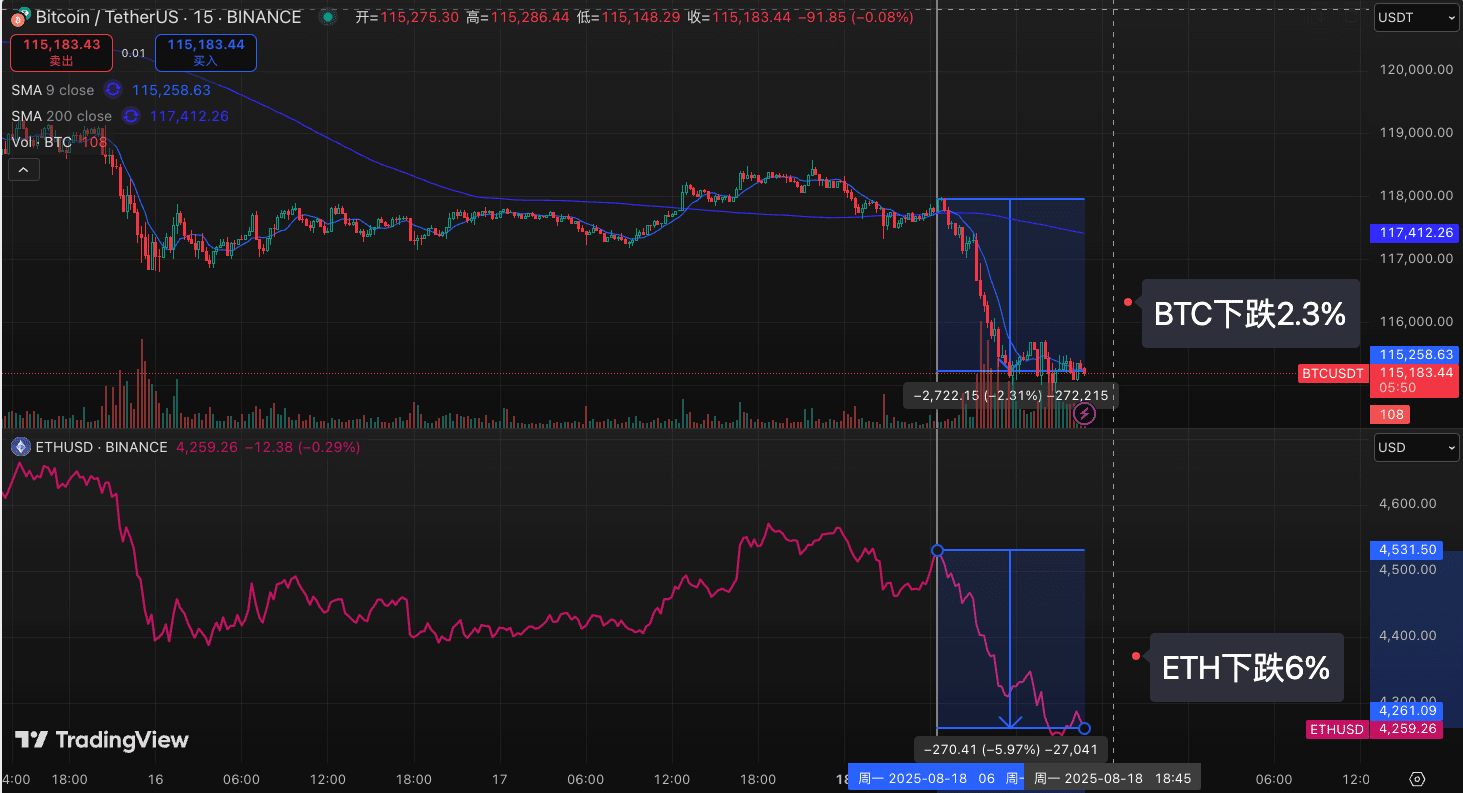When the market suddenly drops, watching the tokens in your hands shrink continuously, is there really no way to respond other than watching?
The answer is certainly negative. In trading, there is a high-level strategy—exchange rate trading (Pairs Trading)—that allows you not only to retreat unscathed during a market crash but even to profit against the trend.
Today, we will use a phenomenon from the recent market correction to analyze what exchange rate trading is and how to engage in it:
We can easily observe that during most market downturns, although both Bitcoin and Ethereum have fallen, the decline of BTC is much smaller than that of ETH. What trading opportunities and principles are hidden here? How should we operate?
I. Understanding Exchange Rate Trading: It's Not What You Think It Is
First, let's clarify the concept. The trades we usually make, such as buying $BTC with USDT or selling $ETH ETH to get back USDT, are essentially trading 'Token - Stablecoin (Fiat)'. You're betting whether the price of this cryptocurrency will rise or fall in dollars.
Exchange rate trading, such as ETH/BTC, is about trading 'Token A - Token B'. It measures not how much ETH is worth in dollars, but how many BTC one ETH is worth.
It's like comparing the currencies of two countries: when comparing yen to dollars, you are betting on the appreciation or depreciation of the yen against the dollar; whereas if you trade yen against euros, you are betting on the relative strength of the yen against the euro.
Therefore, in the ETH/BTC trading pair:
Going long (Long) ETH/BTC: This means you believe ETH will perform better than BTC. This could be because ETH rises faster than BTC or falls slower than BTC.
Going short (Short) ETH/BTC: This means you believe ETH will perform worse than BTC. This could be because ETH rises slower than BTC or falls faster than BTC.
Understanding this, you will find that even with the entire market declining, the ETH/BTC exchange rate still presents huge trading opportunities.

II. In a market downturn, should you go long or short?
Returning to the phenomenon we initially mentioned: a significant market drop, with BTC showing stronger resilience, while ETH and other mainstream tokens decline more. This is a very typical market characteristic, and there are two main reasons behind it:
Market Consensus and 'Digital Gold': In the eyes of many investors, Bitcoin is seen as the 'digital gold' of the crypto world, the ultimate scarce asset and store of value. Therefore, during market panic and capital seeking safe havens, funds tend to flow towards BTC compared to other high-risk assets, giving it stronger resilience.
The 'Risk Asset' Nature of Ethereum: Ethereum is not just a blockchain; it is a vast ecosystem that hosts countless DeFi, NFT, and various DApps. Its price volatility is influenced not only by its own technological updates but also highly correlated with the overall prosperity of the ecosystem, on-chain activity, and even the macroeconomic environment. Thus, when market risk appetite decreases, ETH is more likely to be seen as a high-risk asset, and its price volatility is usually higher than that of BTC.
Based on the general perception that 'BTC is more resilient, ETH is more prone to decline', savvy traders will immediately realize: this is an excellent opportunity to short ETH/BTC.
Operational Principles:
When you choose to short ETH/BTC, you are actually making a 'relative' trade. You sell ETH and buy BTC. Your profit does not come from the absolute price drop of ETH, but from the depreciation of ETH relative to BTC.
For example:
Assuming the market crashes, ETH falls from $4000 to $3000 (a 25% drop), while BTC falls from $120,000 to $100,000 (a 16.7% drop).
If you only hold ETH, your asset has shrunk by 25%; if you only hold BTC, your asset has shrunk by 16.7%.
If you predicted this trend before the market downturn and chose to short ETH/BTC, your operation would be as follows:
Sell ETH at a certain exchange rate (e.g., 0.0333, i.e., 1 ETH = 0.0333 BTC) and buy BTC.
After the market declines, ETH depreciates relative to BTC, and the exchange rate drops to 0.03 (i.e., 1 ETH = 0.03 BTC).
At this point, you buy back ETH at an exchange rate of 0.03, closing your short position.
You exchanged less BTC to get back the same amount of ETH, and the extra BTC is your profit.
Even when both currencies are falling in dollar terms, you can still gain relative value by shorting the exchange rate pair. This is the essence of exchange rate trading.

III. Exchange Rate Trading: A More Robust 'Market Neutral' Strategy?
Then, the next question to answer is: Is trading pairs more robust than trading a single cryptocurrency?
First, the conclusion: under certain circumstances, yes.
The core concept here is 'Market Neutral Strategy'.
When you trade a single cryptocurrency (e.g., going long BTC/USDT), your profit and loss depend entirely on the performance of the overall crypto market. If the market rises overall, you may profit; if the market falls overall, you will incur losses. Your position is highly correlated with market performance, and this risk is known as systemic risk or β risk.
When trading exchange rate pairs, your goal is no longer to predict the market's ups and downs, but to predict the relative performance of two assets. For example, you believe ETH will perform worse than BTC, regardless of whether the overall market is bullish, bearish, or consolidating.
The advantage of this strategy is:
Hedging Systematic Risk: By simultaneously going long on one coin and short on another, your positions can hedge against overall market fluctuations to a certain extent. Your profits primarily come from the relative price difference between the two, rather than the absolute price fluctuations. This makes your trading more stable, especially during periods of extreme market volatility.
Focusing on α Returns: In finance, α (Alpha) represents excess returns that exceed the average market return. Exchange rate trading enables you to focus on discovering the unique relative value between two assets, thereby capturing alpha returns rather than simply following market beta fluctuations.
This certainly does not mean that exchange rate trading is without risk. If your judgment is wrong, and for example, BTC falls more than ETH during a market crash, your short position will also incur losses. However, compared to pure single cryptocurrency trading, it offers a more advanced and robust risk management perspective, allowing you to find a foothold even in a turbulent market.

Summary
In the crypto market, trading a single cryptocurrency is like going solo in the wilderness; your fate is closely tied to the overall trend; while exchange rate trading is like strategizing your troops; you deploy different units and can achieve victory through localized tactical advantages even when the overall battlefield is collapsing.
Next time the market adjusts again, you can not only avoid 'sitting idly and waiting for the axe', but also observe whether there is a relative strength relationship like 'BTC outperforms ETH' in the market. If the judgment holds, you might consider shorting the weaker token against the stronger one in a more intelligent and robust way, calmly responding to the changing tides of the market.


